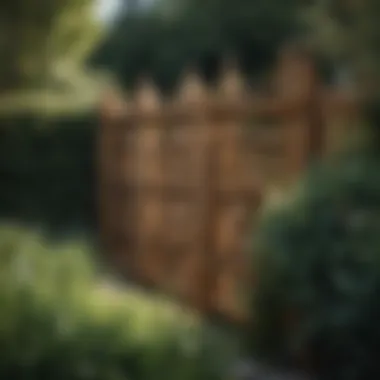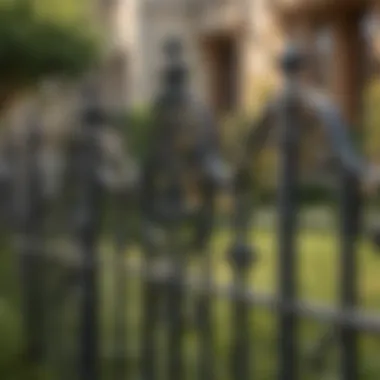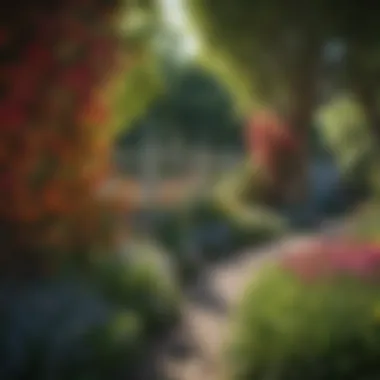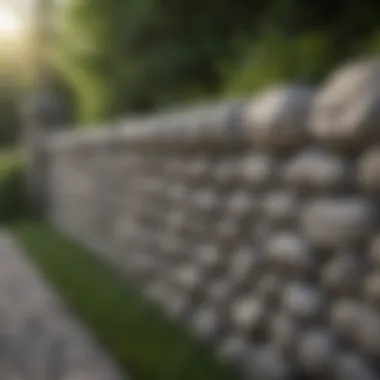Enhancing Outdoor Spaces with Decorative Lawn Fencing


Intro
Decorative lawn fencing serves not just a boundary, but also a significant role in enhancing the visual appeal of outdoor spaces. Whether it is used in a garden, around a pool, or to frame a landscape, these fences can complement the overall design while providing functional benefits. This article aims to explore various materials and styles of decorative fencing, their maintenance, and provide insights to help individuals make informed decisions tailored to their aesthetic and practical needs.
Outdoor Decor Ideas
Seasonal Inspirations
In each season, decorative lawn fencing can fulfill distinct roles and complement nature's changes. In spring, vibrant blooms can cascade against a picket fence, while in autumn, a more muted, rustic wooden fence may align beautifully with the falling leaves. Individuals can enhance these aesthetics by incorporating seasonal accents, such as garlands or themed decorations that blend with the periodic changes around.
Furniture Selection
Quality furniture can harmonize with decorative lawn fencing. For example, wrought iron furniture pairs well with traditional wrought iron fences. On the other hand, modern aluminum fencing can beautifully contrast natural wooden outdoor seating. Careful selection of materials will create a cohesive and upscale look.
Decorative Lighting
Lighting can accentuate the beauty of fencing at night. Strategically placed lanterns or string lights along the fencing can create an inviting ambience. It is essential to choose lighting that resonates with the fence's material — for instance, soft glow LED fixtures can enhance the elegance of a white vinyl fence, creating a sophisticated evening setting.
Plant Arrangements
Plantings can significantly enhance decorative fencing. Climbing plants like ivy or roses can soften a hard fence line. Low-height blooms in front of solid structures can draw the eye and provide color. Arranging native plants ensures a sustainable landscape that is easy to maintain while adding charm.
Hardscaping Solutions
Incorporating pathways and patios can provide not only functionality but also a visual framework for decorative fencing. Materials like stone or pavers can create material harmony and counterbalance the fencing. Planning these elements strategically can enhance the overall design while adding elegance to outdoor areas.
Sustainable Practices
Sustainable landscaping integrates the principles of preserving the environment. Choosing eco-friendly materials for fencing, like reclaimed wood or bamboo, can benefit the planet and also bring a unique character to your outdoor space. Regular maintenance using non-toxic products ensures landscaping choices remain sustainable and vibrant.
"An effective decorative fence is more than just an aesthetic choice; it serves as an important element in the overall landscape management and outdoor comfort."
This concludes the initial exploration of how decorative lawn fencing impacts outdoor design. A thoughtful approach to these elements allows for a more refined outdoor experience.
Prelims to Decorative Lawn Fencing
Decorative lawn fencing plays a significant role in outdoor design, blending functionality with aesthetic value. This type of fencing creates a visually appealing environment, while also serving practical purposes such as defining boundaries and providing security. The choice of decorative fencing can elevate an outdoor space, influencing the overall character and charm of a property.
By integrating elements of style and utility, decorative lawn fencing transforms mundane yards into inviting landscapes. Homeowners and designers alike appreciate the influence of such fencing on curb appeal, property value, and personalization of outdoor areas. As various materials and styles become available, the ways to express tastes and preferences grow exponentially. An informed decision on fencing not only considers aesthetics but also aspects such as maintenance and durability.
The Evolution of Lawn Fencing
The concept of lawn fencing has evolved over centuries. Originally, fences were purely functional, serving to keep livestock contained or mark territorial boundaries. Over time, it gradually transitioned from utilitarian structures to decorative features that enrich outdoor spaces. Different historical periods have contributed distinct styles to fence design, reflecting cultural values and artistic trends. For example, picket fences arose in the 19th century, emphasizing quaint and charming aesthetics, while modern materials and designs—like metal and composite fencing—offer more contemporary and minimalistic options.
Today, homeowners have access to a wealth of choices, blending tradition with innovation to find what aligns best with their vision. This continual evolution has led to an increasing emphasis on both form and function in fence design.
The Importance of Aesthetic in Fencing
Aesthetics in fencing are paramount to creating an appealing outdoor ambience. The right fencing enhances the beauty of a garden or yard, complementing landscaping and architecture. Decorative fencing acts like a frame for the outdoor scene, accentuating its best features and creating a harmonious balance.
Moreover, well-designed fencing can reflect personal style and elevate the aesthetic identity of the property. For luxury travel curators, high-end interior designers, and personal stylists, understanding the importance of aesthetics in fencing can significantly enhance the appeal of outdoor settings.
"A well-thought-out fence can become a statement piece, not merely a boundary."
Materials for Decorative Lawn Fencing
Understanding the materials available for decorative lawn fencing is essential for those seeking to enhance their outdoor space. The choice of materials significantly influences the overall look, durability, and functionality of the fencing. Each material comes with its unique attributes, pros, and cons. This section delves into various materials—wood, metal, vinyl, and composite—along with their specific characteristics and suitability for different landscaping needs.
Wooden Fencing
Types of Wood


Wooden fencing can vary greatly depending on the type of wood selected. Common choices include cedar, pine, and redwood. Cedar is popular for its natural resistance to decay and insects, making it a wise investment for many homeowners. Pine is generally more affordable but may require more maintenance over time. Redwood's beauty and durability also make it a favored option, though it often comes at a higher price. These woods contribute to the traditional aesthetic that wooden fencing is known for, adding warmth and charm to outdoor spaces.
Benefits and Drawbacks
The benefits of wooden fencing encompass its aesthetic appeal and natural qualities. It can be stained or painted to match the home’s exterior, providing flexibility in design. However, there are drawbacks to consider. Wood can be susceptible to weathering, rot, and pests, necessitating regular maintenance. This aspect could lead to additional long-term costs, which homeowners need to factor in their decision-making process.
Finishing Options
Finishing options for wooden fences include staining, painting, and sealing. Staining can enhance the wood’s natural grain while providing some protection against the elements. Painting offers a broader color range but requires reapplication over time. Sealing the wood helps in moisture resistance, thus prolonging the fence's life. Each finishing option carries its own maintenance implications and visual outcomes, which are vital to consider when selecting wooden fencing.
Metal Fencing
Types of Metal
Metal fencing encompasses options such as aluminum, steel, and wrought iron. Aluminum is lightweight and resistant to corrosion, making it a practical choice for various climates. Steel, being more robust, offers greater security. Wrought iron, while traditionally glamorous, usually requires significant maintenance due to its susceptibility to rust. These metals provide different looks that can complement a variety of architectural styles.
Corrosion Resistance
Metal fencing's resistance to corrosion, particularly in aluminum and galvanized steel, is a key advantage. This quality ensures longevity and minimal maintenance compared to wooden options. The lack of susceptibility to common environmental factors makes metal fencing an appealing choice for many homeowners. However, wrought iron can pose challenges in damp areas, as it needs protective coatings to prevent rusting.
Design Options
Metal fencing design options are vast and can range from simple industrial styles to ornate, decorative choices. Many homeowners appreciate the strength and sleek appearance metal fences offer while enjoying a degree of customization in design. This flexibility in aesthetics can make metal fencing a versatile solution for those aiming to enhance their outdoor space visually.
Vinyl Fencing
Durability
Vinyl fencing is known for its exceptional durability. It is resistant to fading, cracking, and warping, which is a significant advantage over other materials. This long-lasting nature makes it appealing to homeowners who desire a low-maintenance option. Additionally, vinyl does not require periodic staining or painting, resulting in cost savings and convenience.
Maintenance Requirements
The maintenance for vinyl fencing is comparatively minimal. Regular cleaning with soap and water suffices to maintain its appearance. Unlike wood, vinyl does not need replacement or significant repairs due to its durable nature. However, it can be prone to scratches or dents, which may require attention if aesthetics are a primary concern.
Cost Considerations
Cost considerations for vinyl fencing can be misleading. While the initial investment may be higher than wood, the longevity and minimal maintenance can lead to cost-efficiency over time. Homeowners should assess their budget not only in terms of immediate expenses but also long-term savings associated with durability and upkeep.
Composite Fencing
Material Composition
Composite fencing is made from a mix of plastic and wood fibers, allowing it to deliver the aesthetic of wood without some of its disadvantages. This unique composition provides the benefits of both materials, offering a visually appealing product that is also practical. The material can resist weathering while maintaining an attractive look suitable for various outdoor setups.
Environmental Impact
From an environmental standpoint, composite fencing can be seen as a more sustainable choice. Many composite products are manufactured from recycled materials, minimizing the carbon footprint associated with fencing. Homeowners who prioritize eco-friendly options may find composite fencing aligns well with their values while providing an attractive solution.
Longevity
The longevity of composite fencing often surpasses that of traditional wood, with many manufacturers offering warranties. Its characteristics mean it requires little more than an occasional wash to keep it looking good. That said, the upfront costs can be higher, so a homeowner’s budget is an important consideration. Taking the long-term value into account is crucial when deciding on fencing materials.
Styles of Decorative Lawn Fencing
The choice of style in decorative lawn fencing significantly influences the overall aesthetic and functionality of outdoor spaces. A well-chosen style can enhance the landscape, complement architectural features, and meet specific needs of homeowners. Understanding the various styles allows individuals to select options that reflect personal tastes while also fulfilling practical requirements, such as privacy, security, and boundary definition.
Traditional Styles
Picket Fences
Picket fences stand as a quintessential symbol of traditional Americana. Their simple, clean lines offer an inviting appearance to both homeowners and guests alike. Typically made from wood, these fences are characterized by evenly spaced vertical boards (pickets) attached to horizontal rails. One of the main advantages of picket fences is their ability to create a defined space without fully obstructing views. They enhance curb appeal, making them a popular choice among those seeking to maintain an open and welcoming environment.


However, picket fences may present drawbacks, such as maintenance demands. Wood can be susceptible to weather damage, requiring regular painting or staining to preserve appearance and durability.
Split Rail Fences
Split rail fences provide a rustic charm that is often associated with rural and country landscapes. Constructed from logs or timber split into rails, these fences typically consist of two or three horizontal rails supported by vertical posts. Their open design allows for visibility while clearly delineating property lines, contributing to the open feel of a yard. Split rail fences are favored for their simplicity and affordability, making them an attractive option for those looking for versatile boundary markers.
On the downside, split rail fences offer minimal security and privacy. Their structure allows pets and wildlife easy access, which may not suit all homeowners' needs.
Modern Styles
Horizontal Slat Fencing
Horizontal slat fencing has gained popularity in contemporary designs for its sleek and modern aesthetic. By using long, narrow planks arranged horizontally, this style adds a sense of sophistication to outdoor spaces. The uniform lines create a sense of continuity and can enhance the visual length of a yard or garden, making spaces appear larger.
The key benefit of horizontal slat fencing is its ability to provide ample privacy while still allowing light and air to flow. This balance makes it a preferred option for urban dwellers wanting to maintain a connection to their surroundings while ensuring personal space.
A potential disadvantage is the need for precise installation. Gaps and alignment errors can quickly detract from its intended sleek appearance.
Minimalistic Designs
Minimalistic designs in fencing are gaining traction among those who prefer understated elegance. These fences often use clean lines, limited ornamentation, and a focus on function over form. Minimalistic styles promote simplicity, allowing landscapes to shine without distraction. This approach suits high-end designs where other landscape elements, such as plants and garden features, are meant to stand out.
The main advantage of minimalistic designs is their adaptability. Such fences can easily integrate into various design themes, from modern to zen gardens. However, their simplicity may not provide the level of security desired by some homeowners, requiring additional measures for privacy.
Themed Designs
Garden Fences
Garden fences serve a dual purpose: to delineate garden areas and to add to the aesthetic of landscaping. These designs can vary widely, featuring trellises, lattice, and decorative elements that enhance the beauty of plants. Solid garden fences often provide privacy, whereas open designs may create an engaging visual of the garden itself.
The unique feature of garden fences lies in their ability to blend functionality with artistic expression. However, depending on the style chosen, some garden fences may require more maintenance due to exposure to weather and plant growth.
Ranch Style
Ranch style fencing resonates with expansive properties and offers a direct connection to outdoor living. This style typically uses wooden posts and wire to mark boundaries seamlessly. Its primary characteristic is the practical approach to securing livestock or defining property lines effectively.
The ranch-style design is popular for its straightforwardness and low maintenance. Many homeowners appreciate the rustic feel it brings. Still, it may not provide the same level of security or privacy as more closed fencing options, which some might find limiting.
Ultimately, the choice among these styles should reflect personal preferences, landscape requirements, and maintenance considerations. Understanding the benefits and disadvantages of each can guide informed decisions for enhancing outdoor spaces.
Functional Benefits of Decorative Lawn Fencing
Decorative lawn fencing does not only serve an aesthetic purpose. It integrates practicality into outdoor design, which is crucial for homeowners seeking to balance form and function in their landscapes. Each functional benefit contributes to the overall ambiance and safety of an outdoor space while enhancing its visual appeal. Understanding these benefits allows individuals to make informed choices when selecting a fencing solution that aligns with their specific needs.
Privacy and Security
Privacy is a fundamental concern for many homeowners. Decorative lawn fencing provides a level of seclusion from neighboring properties that is often essential for feeling secure in one's yard. A taller fence can deter prying eyes and create a more intimate space for leisure activities. In urban areas, where homes are closely situated, this feature becomes even more critical.
Security is another vital aspect. A solid fence can act as a barrier against unwanted intrusions. Many types of decorative fencing can be designed to incorporate height and materials that are hard to breach, thereby preventing potential intruders from entering the property. The right fencing options also convey a message of security to potential intruders, fostering a sense of protection for homeowners.
Boundary Definition
Establishing clear boundaries is essential in landscape management. Decorative fencing serves to define property lines visually and physically. This can prevent disputes with neighbors about property boundaries and provides a clear delineation of space. By marking the limits of a property, it ensures that all parties understand their respective spaces.
Additionally, fencing can enhance the style of a landscape by emphasizing formal garden areas, vegetable patches, or pools. Different fencing materials and designs, such as wrought iron or picket designs, can create distinctive boundaries that enhance the landscape aesthetics while serving a functional purpose.
Wildlife Protection
Another significant benefit of decorative lawn fencing is wildlife protection. Depending on the location, properties may be at risk from animals such as deer, rabbits, or even smaller creatures. A well-designed fence can help protect gardens and landscaping from being destroyed by these animals.
By investing in the right type of fencing, homeowners can enjoy their outdoor spaces without the constant worry of animal intrusion. Such fencing acts as a deterrent, allowing the cultivation of flowerbeds and vegetable gardens without the fear of wildlife damage. Therefore, considering the potential for wildlife disturbances can enhance the overall enjoyment of outdoor spaces.


Decorative fencing not only embellishes your yard but also provides tangible security and privacy, defines boundaries, and protects vegetation from wildlife.
Maintenance of Decorative Lawn Fencing
Maintaining decorative lawn fencing is crucial for both aesthetic appeal and durability. Proper care enhances the beauty of the yard while also preserving the structural integrity of the fences. The responsibility of maintaining fencing includes cleaning, repairs, and weatherproofing. Each of these elements contributes significant benefits. Regular maintenance prevents costly replacements and ensures that the fencing continues to serve its purpose effectively.
Cleaning and Care
Regular cleaning is essential to prevent dirt, grime, and algae buildup on decorative fences. Depending on the material type, this can vary significantly. For wooden fences, a gentle wash with soap and water, followed by rinsing is sufficient. A power washer can be useful but should be used cautiously to avoid damage. Metal fences may require wiping down with a cloth and possibly a mild detergent to remove residue. Vinyl fencing tends to be easier to maintain; often, a simple spray with water suffices.
Keeping the fence clear of debris, such as leaves and branches, is also important. These can trap moisture and lead to deterioration. Establishing a regular cleaning schedule ensures that the aesthetics remain intact while prolonging the lifespan of the fencing.
Repair Strategies
Over time, decorative fences may suffer from wear and tear due to environmental conditions or accidents. It is important to assess the fence regularly for damages, such as loose boards or rust on metal features. For wooden fences, replacing damaged planks or treating with anti-rot solutions is advisable. When it comes to metal fencing, rust can be a growing problem. One must remove rust with a wire brush and paint over the exposed metal with rust-resistant paint.
For vinyl fences, cracks can occur and may require patching. Minor damages are often fixable with recommended adhesives. Proactive repairs prevent small issues from becoming larger problems, thus avoiding the need for complete replacements.
Weatherproofing Techniques
Weatherproofing is necessary, especially in fluctuating climates. For wooden fences, applying water-repellent sealants can safeguard against moisture and sun damage. It is vital to conduct this treatment at least once a year. Metal fences benefit from weather-resistant coatings that protect against rust and corrosion.
Vinyl fencing is generally resistant to weather, but keeping it clean can help maintain its appearance over time.
"Investing time in maintaining decorative lawn fencing enhances not just the looks, but also the life of the installation."
Overall, weatherproofing helps in retaining the charm of the fencing, ensuring that it serves its functional and aesthetic roles effectively for years. By adhering to these strategies, homeowners can enjoy their decorative fencing without the worries of deterioration.
Regulatory Considerations
Regulatory considerations play a crucial role in the implementation of decorative lawn fencing. It is essential to understand and comply with rules that govern fencing in your area. Not only does this ensure that the aesthetic appeal of the landscape is maintained, but it also safeguards the property owner from potential disputes or legal issues. Understanding these regulations can significantly enhance the decorative and functional potential of lawn fencing.
Local Zoning Laws
Local zoning laws are among the first aspects to consider when planning for decorative fencing. These laws dictate what is permissible in terms of height, design, and placement of fences. Each municipality may have different regulations. Some areas may enforce stricter limitations regarding privacy fences versus decorative styles, while others may allow more flexibility.
Among the primary benefits of adhering to local zoning laws includes reducing conflicts with neighbors. A properly designed and installed fence not only beautifies the landscape but also aligns with the community standards, fostering harmonious coexistence. It's advisable to check with local authorities or the municipal website to obtain precise information.
Furthermore, some zoning codes might specify requirements for fencing near property lines or in front yards. Understanding these nuances enhances the practical application of decidive fencing designs and their placement. Failure to comply may lead to costly modifications or even the removal of non-conforming fences.
Homeowners Association Guidelines
Homeowners Association (HOA) guidelines add another layer of complexity. When living in a community governed by an HOA, it is vital to consider their specific regulations regarding fencing. These guidelines are commonly designed to maintain a certain aesthetic standard within the neighborhood.
Each HOA will have its own set of rules that property owners must follow. These can cover aspects such as materials, colors, and architectural styles. Fences that may be considered attractive and stylish in one neighborhood might not be permitted in another.
Engaging with HOA representatives prior to erecting a fence can save significant time and cost. It ensures all fencing designs align with community expectations and avoid fines or corrections from the association. Most HOAs require homeowners to submit plans for review before making any permanent changes.
In summary, understanding regulatory considerations, including local zoning laws and HOA guidelines, is critical for anyone interested in decorative lawn fencing. Compliance leads to better designs that fit within community standards while providing privacy, security, and aesthetic value to the property.
Culmination
In this article, the significance of decorative lawn fencing has been thoroughly explored as an essential feature in outdoor design. The interplay between aesthetics and functionality forms the core of its value. Decorative lawn fencing not only enhances the visual appeal of outdoor spaces but also serves various practical purposes that cannot be overlooked.
Key Takeaways
Decorative lawn fencing elevates the style and character of a property, creating a refined boundary that complements garden themes. The diverse materials, from wooden options to modern vinyl, provide choices that suit both taste and need. Moreover, this type of fencing plays a crucial role in privacy, defining property lines, and offering protection from wildlife.
Practical Considerations
When selecting a decorative fence, one must consider local zoning laws and potential restrictions imposed by homeowners associations. Knowledge of these regulations is important to ensure compliance and avoid conflicts down the line.
"A well-chosen fence can transform an ordinary outdoor space into an extraordinary sanctuary, reflecting the owner's style while also providing necessary functions."
The Path Forward
Ultimately, the decision to invest in decorative lawn fencing should integrate aesthetic desires with practical considerations. One must not only select designs that resonate personally but also contemplate durability and maintenance needs. By doing so, homeowners can achieve a seamless blend of beauty and utility, crafting a space that is as inviting as it is functional.
In summary, decorative lawn fencing is not merely an accessory; it is a pivotal element in outdoor design that warrants careful consideration. Its multifaceted role in enhancing aesthetics while addressing practical needs makes it a worthy investment for any discerning property owner.







